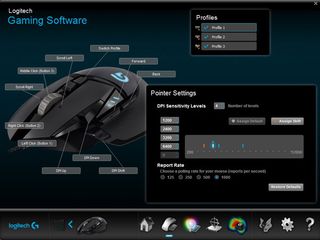Logitech G502 Proteus Spectrum Guide
With the Logitech G502 Proteus Spectrum, you can set up profiles for individual games, adjust the backlighting and tweak the weights. Here's how to get started.
How to Set Up Profiles

There are two profile types on the Proteus Spectrum: three onboard profiles, or an unlimited number of computer-based profiles. Either way, you create profiles using the same process, although if you use computer-based profiles, you can link them with individual programs as well.
On the home screen (the house icon on the lower right), you can switch between onboard and computer memory just by clicking on either the mouse icon or the computer icon. After that, click on the mouse icon on the lower right. Choose a profile on the upper right. Onboard memory has three profiles, whereas for computer memory, you can create as many as you'd like. The software will automatically save your assignments as you make them.
For computer-based profiles, you can even link them to automatically start up with certain programs. When you click the scan button (the pie-chart circle between the plus sign and the folder), it will show games that Logitech automatically recognizes, but you can add any program manually by using the plus sign. As long as the software is active, the proper profile will launch automatically when you open a game.
To further differentiate them, you can also give different lighting patterns to each profile. Click on the colored light bulb in the bottom right; then check "Enable per profile backlight settings." From there, you can set up color combinations (see below) and save them to individual profiles.
Sign up to get the BEST of Tom's Guide direct to your inbox.
Get instant access to breaking news, the hottest reviews, great deals and helpful tips.
Current page: How to Set Up Profiles - Logitech G502 Proteus Spectrum Guide
Prev Page How to Program Buttons - Logitech G502 Proteus Spectrum Guide Next Page How to Change DPI - Logitech G502 Proteus Spectrum GuideMarshall Honorof is a senior editor for Tom's Guide, overseeing the site's coverage of gaming hardware and software. He comes from a science writing background, having studied paleomammalogy, biological anthropology, and the history of science and technology. After hours, you can find him practicing taekwondo or doing deep dives on classic sci-fi.
